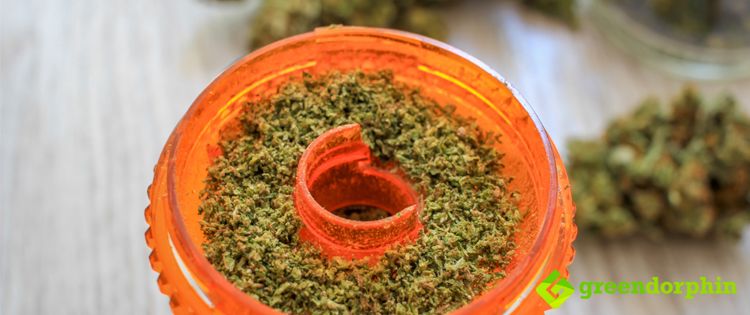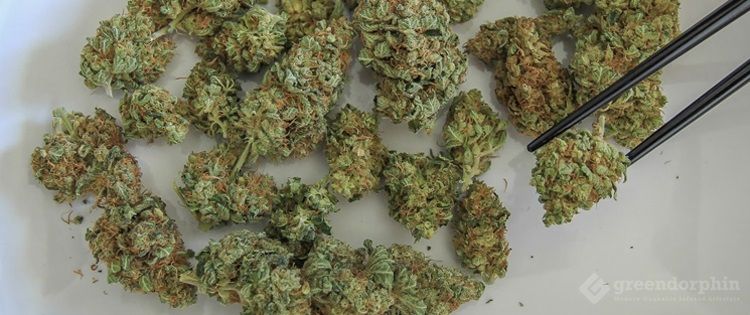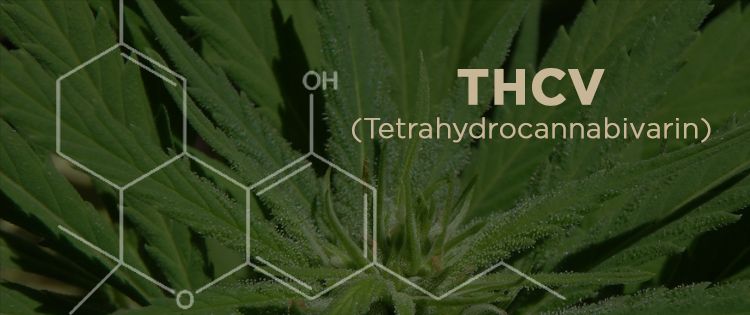Tetrahydrocannabivarin (also known as THCV) is well on its way to becoming one of the next well-known cannabinoids. Similar to THC in molecular structure and psychoactive impact, THCV has very pronounced and different effects.
The cannabinoid intensifies the euphoric high created by THC but lasts about half as long. The high it creates is a clear-headed buzz. It also works as an appetite suppressant. This means it might hold promise eventually as part of a weight loss drug.
Medically, THCV may help with diabetes management. Research shows a lot of promise in terms of THCV’s ability to regulate blood sugar levels. THCV also appears to reduce insulin resistance. The cannabinoid also appears to curb PTSD-caused panic attacks, help control Alzheimer-related tremors and stimulates the growth of new bone cells.

The Chemistry of THCV
The majority of cannabinoids are synthesized from a compound called cannabergerol, found in the cannabis plant. THCV, however, is not formed during this process but rather as a result of the natural plant growing process.
When smoked, THCV binds fully to CB1 receptors and partially to CB2.
Where Do I Find THCV Prominent Strains?
The best place to find this cannabinoid is in African Sativa strains, particularly landrace strains. Durban Poison is the most common high THCV strain but it is not the only one. Cherry Pie, Doug’s Varin, Pineapple Purps, Power Plant, Jack The Ripper and Durban Cheese are all good varieties to select when looking for higher THCV.

Remember that most strains contain trace amounts of this cannabinoid, but at such low levels that its desired therapeutic effects are unnoticeable.
What Are The Effects?
The effects of smoking a THCV-rich strain are varied.
On the recreational side, users report being highly energized. They also report that the euphoric “high” is more intense.
Medically, the drug appears to have a similar impact to THC, except that some of the more negative side effects (such as anxiety) are not as common. GW Pharmaceuticals is studying THCV as the basis for a diabetes drug.
The largest reason for THCV’s elevation of interest in scientific communities, beyond symptom relief, however, is the appetite suppressing aspect of the compound.

Other Uses
THCV has a boiling point more than 100° higher than THC. THC’s boiling point is 314 Fahrenheit (157C°). THCV boils at 428F° (220C°). This means you can prepare edibles at a higher temperature without damaging the THCV. However, it does not mean you should cook your canna-edibles at a higher temperature. Many of the terpenes and other cannabinoids in the plant have low boiling temperatures.
What this does mean, however, is that if vaping the drug, you will need one of the highest settings to get the most out of your bud.

More Research Is On The Way
Because of its unique properties that set it apart from THC, THCV is on the drawing board of both pharma companies and start-ups everywhere there is a marijuana industry. This includes Israel.
GW Pharma, the British cannabinoid maker has stated that “in pre-clinical studies, THCV has shown effects on body weight, body fat content, energy expenditure, food intake and other obesity-related parameters.”
Steep Hill Labs, a leading cannabis research, and development firm in Berkeley California has also found that “THCV has been found to reduce or even block panic attacks and, as a result, can be highly effective in the management of PTSD and other mental disorders involving anxiety or stress.”

Because of its similarity to THC-A – the acidic precursor to THC – the cannabinoid is suspected to have equally impactful and positive effect on inflammation.
THCV Comes From Landrace Strains
One of the most interesting aspects of this cannabinoid is that it is found predominantly in what are called “Landrace” cannabis strains. These are indigenous strains of cannabis found in many different places in the world.
Their impact is that they are wild cannabis strains, which have developed naturally rather than being hybridized or mixed with other strains for a certain effect. They are not commercially developed, in other words.
In a rapidly commoditizing industry, this makes them not only all the more rare, but of value because of the impact of these strains on further development of the cannabis plant for specific purposes.

With the emergence of a professional breeding industry, not to mention “strain hunters” who search for such landrace varieties across the globe, such “pure” strains are also increasingly under threat. The reason? Growers in the remote areas where landrace grows are increasingly cross-pollinating their own crops with commercially produced strains.
The value found in THCV, however, and presumably other so-far under-researched cannabinoids is reinvigorating the discussion about the importance of preserving landrace cannabis strains.
Share your views with our community in the comment section below.
- Guenter Weiglein – The Persevering Patient - July 7, 2017
- Dr Peace – A German Cannabis Doctor On The Go - July 5, 2017
- The German Marijuana Edibles Market - July 3, 2017


